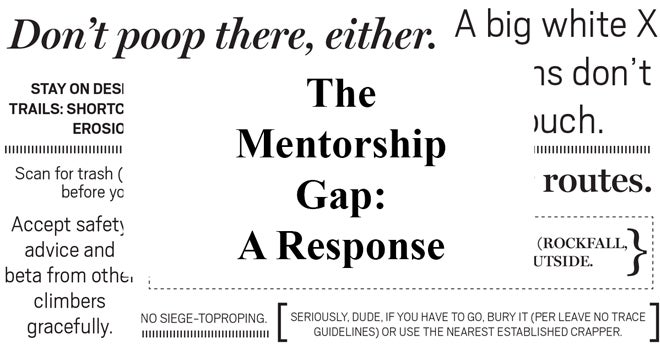The Mentorship Gap: A Response

"HPMentor"
In the May 2014 issue of Climbing, we published The Mentorship Gap. The article explored the issue of climbing’s increased popularity and its impact on outdoor conditions and access. It prompted a range of responses. Evening Sends blogger Andrew Bisharat posited that climbing gyms aren’t the problem, assholes are. Climbing Business Journal found the article insulting to gym climbers. Others agreed with it whole-heartedly. Author Chris Noble took the time to further the discussion.
First I’d like to thank everyone for their response to my article The Mentorship Gap in the May issue of Climbing. Judging from the comments received, most people agree that the large numbers of new climbers entering the sport are having increasing affects in terms of safety, environmental impact, and user experience.
There’s far less agreement on why this is so, and what to do about it, which is to be expected with a topic as broad and complex as this. Critics of the piece brought up a number of valid points, the primary one being— that gyms and gym climbers are not to blame—an opinion with which I whole-heartedly agree.
Saying that gyms are the cause of the problems facing climbing today would be akin to saying that, because sex can lead to overpopulation, sex is bad. I want to go on record by saying that I personally frequent climbing gyms and have sex as much as possible. In fact, I encourage everyone to indulge liberally in both activities, and spend far less time ranting and raving about what an article in Climbing did or did not say.
Since apparently I wasn’t clear enough—the point of the article is that there is an education gap in modern climbing that needs to be addressed. This is not my opinion and my opinion only; it is also the opinion of the Access Fund which has stated repeatedly that they see the rising number of new climbers to be the biggest threat facing American climbing access today. That’s why they went to the trouble of hosting a summit conference on the subject which is the basis for the information in the article. It is also the opinion of the American Alpine Club, which launched an education initiative aimed at new climbers at their Annual Meeting in Denver last February. It is also the opinion of all the land managers and climbers (both pro and recreational) I spoke with when preparing the article. And it’s the opinion of Climbing magazine who commissioned me to write the piece in the first place.
A magazine article is a remarkably limited form of expression, more like a limerick, than an in-depth exploration of a challenging topic. All that can be hoped is that it provides a starting point—getting people thinking and talking. And in that this article appears to have succeeded. I don’t pretend to be an expert or to have all the answers. That’s up to the climbing community as a whole. What I suggest is that if you read this article and feel strongly about some aspect of it, do something that contributes to solutions, not further argument. Don’t waste your time ranting in a post. Get involved with the Access Fund or the AAC. Join your local climbing organization, or find a way to work with young climbers. Write your favorite brands and tell them you want to see them get involved. Talk with your local gym owners and ask what they are doing to bridge the education gap. What I do know, is that if climbers do not come together to address these issues, then we will see ever more closures, restrictions, permitting, and regulations. And that would really be something to be upset about.
Tell us your thoughts in the comments area below or email us atletters@climbing.com.